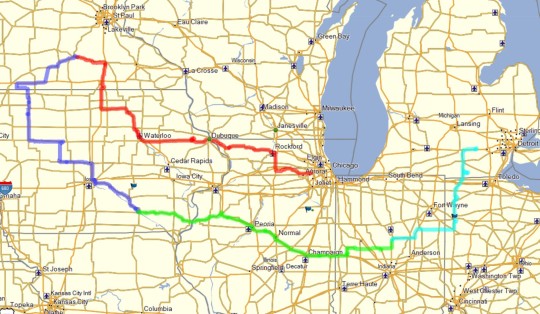Don't wanna be here? Send us removal request.
Text


Day four of the 2023 IAG Crop Tour (final day)
Data from today. 270 miles driven. Average moving speed of 47.4 mph. Elevation min was 658ft, the max was 1120ft and we ascended and descended about 4k ft during the route. Our final tally is 24 crop stops and sampled nearly 50 fields of corn and soybeans.
A shorter day as we all got ready to split up and go home. We began in Kokomo, IN and headed east-northeast towards Ohio, and finally finished in south-central Michigan.
As we circled south and east of Fort Wayne, IN we started with exceptional yields that declined as we moved towards Ohio. We expect some potential was lost in northwestern Ohio generally due to early stress issues whether it be planting problems, compaction, or the dry June. Despite 3 corn samples from Van Wert, OH to Hudson, MI, our spot yield checks were consistent (from 190-200bpa). Soybeans were generally healthy but not as far along as what we had seen west of Indianapolis. As we turned North, we noticed pod fill was further behind. For the first time this tour, we found beans that need some finishing rains.
That’s it for tonight’s wrap up. Tomorrow we will start crunching the numbers and will have our final report out which a lot more details of the trip. This is the 2023 IAG Crop Tour, signing off.
0 notes
Text
0 notes
Text
0 notes
Text
0 notes
Text




The bean field in Hudson, MI was not exactly representative of the area as a whole. It was the best bean field we've seen and is more a look at what the potential of a field can be when there is irrigation available. The plants were huge, the bottoms of the stalks were about as big as a thumb, average 90 pods/plant and 3 pods/node. We've been joking the last few days that all the bean fields are estimated at 60 bpa, but with a field this good looking, we're estimating 80+ bpa. #soy yields #croptour
0 notes
Text




The final stop of the 2023 IAG crop tour led us to one of Ben's family friend's farms in Hudson, MI. I think all of us were happy to wade through the last corn field of the trip and hang out for a few before we all split up to go our separate ways. The corn stalks were the tallest of all the fields we'd been in, and the ears were about head height. The corn was still maturing, entering dent, population about 32k ears/acre - we know they dropped 34k. Ear sizes were fairly consistent and on average 16 rows and 36 long. We estimate the yield to be 200 bpa. #corn yields #croptour
0 notes
Text
0 notes
Text
0 notes
Text



The bean field in Sherwood, OH looked good, but again the plants were inconsistently spaced. The pods are less than half full, lots of 1 and 2 bean pods, less than 2 pods per node. Similar to Van Wert, we estimate the yield to be 45 bpa. #soy yields #croptour
0 notes
Text




The corn in Sherwood, OH still had a ways to go. The husks were still green, the ears were in early dent, the population was consistent at 32k ears/acre, the ear sizes were fairly consistent at 14-16 rows and 33-40 long. Indication in the field is that this crop had a fairly decent summer. If the ear size is normal, then we can assume that this field produced well. However, we do suspect the ears are a bit on the small side, which could be due to early stress, whether it be from planting, weather or compaction. We estimate the yield to be 190 bpa. #corn yields #croptour
0 notes
Text
0 notes
Text
0 notes
Text



The bean field in Van Wert, OH was a good clean field. The spacing of the plants was uneven, the plants had an excellent color, plants were extremely healthy. The pods were flat to 1/4 full, a lot of 2 bean pods. These beans could use a few more good rains. We estimate the yield to be 45 bpa. #soy yields #croptour
0 notes
Text




Our stop in Van Wert, OH had corn that was less mature than all of the fields we've seen. The population was consistent at 31k ears/acre. Plant health was great, stalks were evenly spaced, ears were just starting to dent. Ear size was fairly consistent - on average 16 rows and 36 long. The moisture reading was 6, which as surprising since this area has recently had a good rain, but we do know that the soil in this area doesn't hold moisture as well as IA & IL. We think increasing the population could have increased the yield in this field. We estimate the yield to be 200 bpa. #corn yields #croptour
0 notes
Text
0 notes
Text



The bean field in Linn Grove, IN had a high population at around 140k, and the spacing of the plants was very inconsistent. The plant health was good with no weeds or insect pressure. As we looked down the rows, we saw some plants that seemed to have almost no pods on them. We tried to sample a couple plants that were evenly spaced. We found some pods that were basically flat and others that were almost full. We also noticed that our sample plants had quite a few leaves. If these plants hustle to finish, we estimate they'll be lucky to get 50 bpa. #soy yields #croptour
0 notes
Text




We stopped in Linn Grove, IN, and the corn field we chose was not great, but we think it was probably a good representative of the rest of the area. We're thinking it was probably too wet when it was planted, and caused the ground to be compacted and led to an emergence issue. The ground looked dry and was full of cracks despite the moisture reading of 8.5. We found a consistently low population at 24k ears/acre due to quite a few skipped stalks and other stalks that were either missing ears or had ears that were too small to be viable. Of the 9 ears sampled, 8 of them had 16 rows and they ranged from 20 to 41 long. We estimate the yield to be 140 bpa. #corn yields #croptour
0 notes